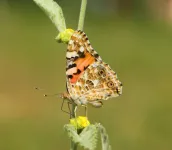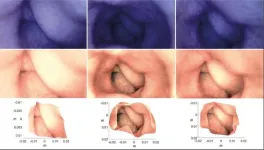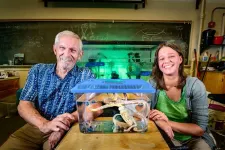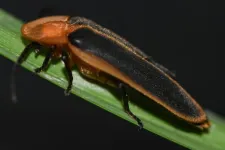(Press-News.org)
An international team of researchers, led by the Spanish National Research Council (CSIC), has documented a transoceanic flight of more than 4200 km by painted lady butterflies (Vanessa cardui), setting a record for an insect.
The study, published in the journal Nature Communications, involved researchers from the Botanical Institute of Barcelona (IBB), a joint center of the CSIC and the Natural Sciences Museum of Barcelona, as well as from the W. Szafer Botanical Institute (Poland), the University of Ottawa (Canada), the Institute of Evolutionary Biology (IBE, CSIC-Universitat Pompeu Fabra), and Harvard University (USA).
In October 2013, Gerard Talavera, a CSIC researcher at the Botanical Institute of Barcelona, identified several painted lady butterflies on the Atlantic beaches of French Guiana. These observations were completely unusual, as this species is not found in South America. Where did they come from?
A sum of novel techniques solves the enigma
A multidisciplinary approach has deciphered the route and origin of these butterflies. The initial hypotheses were that they could have originated in North America, where the nearest populations are found, or that they travelled from Africa or Europe. By analyzing wind trajectories, researchers observed a sustained directional pattern from West Africa, opening the possibility that they had crossed the Atlantic.
By studying the genetic diversity of the butterflies, which required collecting samples from populations on all continents, they determined that the specimens observed in South America were related to populations in Europe and Africa, ruling out the possibility of a North American origin.
The researchers also analysed the pollen DNA that the butterflies carried on their bodies, and identified two plant species found only in tropical Africa, thus proving that the butterflies visited flowers in that region.
Lastly, the researchers analysed the stable isotopes of hydrogen and strontium from the butterflies’ wings. The wings preserve isotopic signatures unique to the place where they were raised in their larval stage, allowing inference of their natal origin. With this data, they determined that their origin was most likely in western European countries such as France, Ireland, the United Kingdom or Portugal.
"The painted lady butterflies reached South America from West Africa, flying at least 4200 km over the Atlantic. But their journey could have been even longer, starting in Europe and passing through three continents, implying a migration of 7000 km or more. This is an extraordinary feat for such a small insect,” explains Clément Bataille, a professor at the University of Ottawa in Canada and co-author of the study.
"We tend to see butterflies as a symbol of the fragility of beauty, but science shows us that they can perform incredible feats. There is still much to discover about their capabilities,’ says Roger Vila, a researcher at the Institute of Evolutionary Biology (IBE, CSIC-Universitat Pompeu Fabra) and co-author of the study.
With the help of the wind
The researchers have modelled the energetic cost of the journey and calculated that the flight across the ocean, without any stop, lasted between 5 and 8 days. This was energetically possible because it was facilitated by favourable wind currents.
"The butterflies could only have completed this flight using a strategy alternating between minimal effort to avoid falling into the sea, facilitated by ascending winds, and active flight, which requires more energy consumption. We estimate that without wind, the butterflies could have flown a maximum of 780 km before exhausting all their fat and thus their energy,’ comments Eric Toro-Delgado, one of the authors of the paper.
The researchers highlight the importance of the Saharan air layer as a potential aerial highway for dispersion. These wind currents, which are prevalent throughout the year, transport large amounts of Saharan dust from Africa to America and participate in important biogeochemical cycles. However, the biological components transported, including living organisms, should be studied in depth.
The potential impact of migration in the context of global change
This finding suggests that natural aerial corridors connecting continents may exist, facilitating the dispersal of species on a much larger scale than previously imagined.
"This discovery opens new perspectives on the capabilities of insects to disperse over long distances, even across seas and oceans. It is possible that we are underestimating the frequency and impact of these movements on our ecosystems,’ comments Gerard Talavera, leader of the study. “Throughout history, migratory phenomena have been important in defining the distributions of species that we observe today,” he adds.
The researchers emphasize that with global warming and changing climatic patterns, it is likely that we will observe greater alterations and even an increase in these long-distance dispersal events, which could have significant implications for biodiversity and ecosystems worldwide. ‘It is essential to promote systematic monitoring routines for dispersing insects, which could help predict and mitigate potential risks to biodiversity resulting from global change’ - concludes Gerard Talavera.
CSIC Comunicación
END
Background and Aims
Hepatocellular carcinoma (HCC) is a highly aggressive tumor with limited treatment options and high mortality. Senecavirus A (SVA) has shown potential in selectively targeting tumors while sparing healthy tissues. This study aimed to investigate the effects of SVA on HCC cells in vitro and in vivo and to elucidate its mechanisms of action.
Methods
The cell counting kit-8 assay and colony formation assay were conducted to examine cell proliferation. Flow cytometry and nuclear staining were employed to analyze cell cycle distribution and apoptosis occurrence. ...
OAK BROOK, Ill. – The structural and functional organization of the brain as shown on MRI can predict the progression of brain atrophy in patients with early-stage, mild Parkinson’s disease, according to a study published today in Radiology, a journal of the Radiological Society of North America (RSNA).
Parkinson’s disease is a progressive disorder characterized by tremors, slowness of movement or rigidity. Symptoms worsen over time and may include cognitive impairment and sleep problems. The disease affects more than 8.5 million people worldwide, and prevalence has doubled in the past 25 years, according to the World Health Organization (WHO).
One of ...
The School of Computer Science at Carnegie Mellon University has launched the CMU TechBridge Coding Bootcamp to provide access to computer science education and career opportunities for high school (or equivalent) graduates.
The bootcamp will extend the reach of CMU’s computer science education offerings beyond its traditional undergraduate and graduate programs. CMU has partnered with TalentSprint to implement the program to help aspiring professionals build the skills required for launching and ...
Weill Cornell Medicine received a $1.5 million grant from the U.S. Department of Defense Prostate Cancer Research Program to develop new approaches for predicting the spread of cancer cells to the bone in men with prostate cancer, using tumor samples taken at early stages of the disease.
The American Cancer Society projects about 35,250 deaths from prostate cancer in the United States in 2024. “Metastases, especially to the bone, is the leading cause of death in men who have prostate cancer,” said principal investigator Dr. Mohamed Omar, assistant professor of research in pathology and laboratory medicine, division ...
“Our work shows that it is possible to re-create a fairly accurate three-dimensional (3D) model of the colon of some patients based on a single image taken by a capsule endoscopy camera - even if it's a low-quality image,” says Pål Anders Floor, a researcher at the Department of Computer Science at NTNU.
Goal: better images, faster diagnoses
He has been working for several years on using images from capsule endoscopy cameras to reconstruct an almost identical 3D model of the intestines. These cameras were first used more than 20 years ago, but low-quality images and image noise prevented this smart technology from ...
Falls are the most common cause of injury among adults 65 and older in the United States. According to the U.S. Centers for Disease Control and Prevention, every year, more than 14 million older adults (one in four) report a fall. About 90% of head injuries among older individuals is due to ground-level falls.
Evaluating an older adult with a head injury in the emergency department (ED) requires careful assessment due to the increased risk of complications such as intracranial hemorrhage. There also is heightened concern for older patients taking anticoagulants or blood thinners who sustain ...
Fertilizers manufactured from the sludgy leftovers of wastewater treatment processes can contain traces of potentially hazardous organic chemicals, according to a new study by Johns Hopkins University researchers.
The research, published today in Environmental Science & Technology journal, provides one of the most comprehensive looks at the chemical composition of so-called biosolids across the country and is the first step toward identifying common chemical contaminants that may need government regulation. The findings could ...
CHAMPAIGN, Ill. — By giving artificial intelligence simple associative learning rules based on the brain circuits that allow a sea slug to forage — and augmenting it with better episodic memory, like that of an octopus — scientists have built an AI that can navigate new environments, seek rewards, map landmarks and overcome obstacles.
Reported in the journal Neurocomputing, the new approach gives AI the ability to explore and gather the information it needs to expand its spatial and temporal awareness, growing its knowledge base while learning on the job, said Ekaterina Gribkova, a postdoctoral researcher at the University of Illinois Urbana-Champaign who ...
The leading hypothesis for the origin of firefly lights has been overturned by a genomic analysis. It had been posited that the bright lights emitted by many species in the Lampyridae family of beetles—better known as fireflies—first evolved as a warning signal to predators, advertising the toxicity of fireflies, and were then repurposed as a mating signal. This explanation would account for why eggs, larvae, and pupae also glow. Ying Zhen and colleagues put the conventional wisdom to the test by compiling a family tree of fireflies and tracing the evolution of the chemical compounds ...
ASAP Launches Data-Sharing Tool with Unique Dataset of Human Postmortem-Derived Brain Samples
Aligning Science Across Parkinson’s (ASAP) launched a platform to make high-value data for Parkinson’s disease broadly available to researchers all over the world
The platform launches with data from a unique human postmortem-derived brain sequencing collection, including samples from four ASAP Collaborative Research Network (CRN) teams and 156 donors
The database will continue to expand, with 629 donors contributing to the final harmonized dataset; there will be a consistent cadence of new ...




